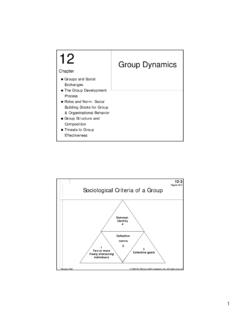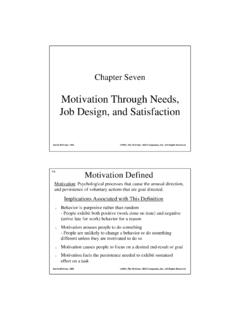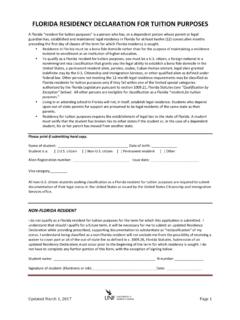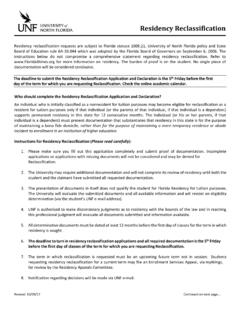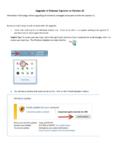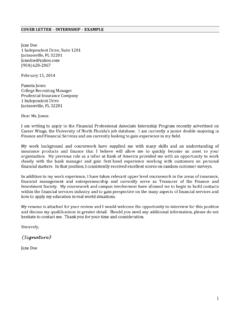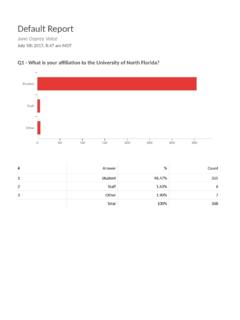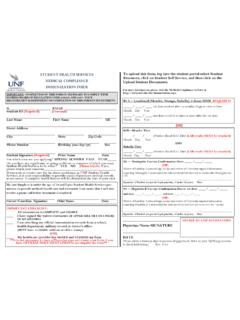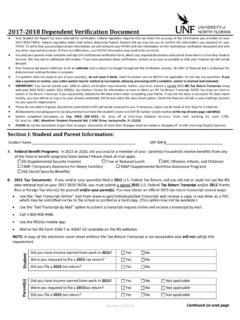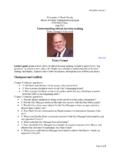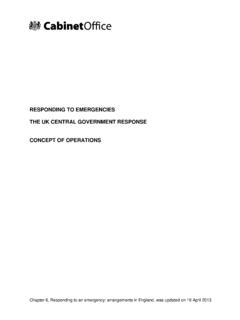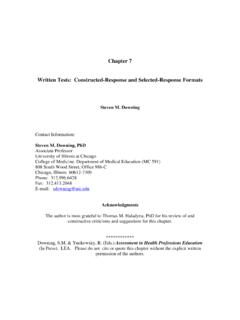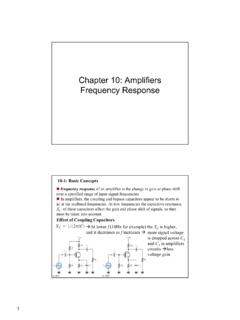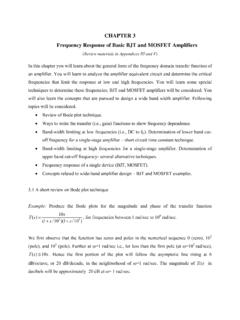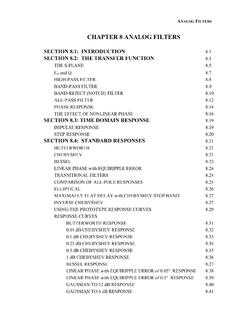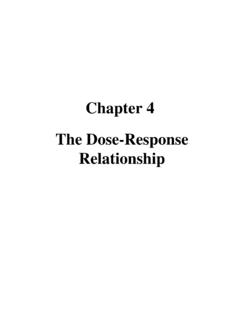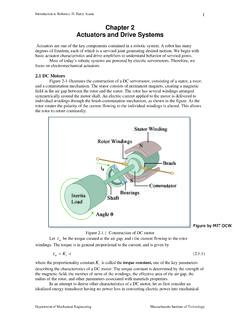Transcription of Elasticities of Chapter demand. and Supply Demand 5
1 1 Elasticitiesof Demand and SupplyChapter5 Copyright 2002 Addison Wesley Chapter , explain the factors that influence, and calculate the price elasticity of , explain the factors that influence, and calculate the price elasticity of and explain the factors that influence the cross elasticity of Demand and the income elasticity of TOPICS<The Price Elasticity of Demand <The Price Elasticity of Supply <Cross Elasticity and Income THE PRICE ELASTICITY OF DEMANDP rice elasticity of demandA measure of the extent to which the quantity demanded of a good changes when the price of the good determine the price elasticity of Demand , we compare the percentage change in the quantity demanded with the percentage change in THE PRICE ELASTICITY OF Demand <Percentage Change in PricePercent change in price =New price Initial priceInitial Pricex 100 Percent change in price =$5 $3$3x 100= percentSuppose Starbucks raises the price of a latte from $3 to $5 a cup.
2 What is the percentage change in price? THE PRICE ELASTICITY OF DEMANDS uppose Starbucks cuts the price of a latte from $5 to $3 a cup. What is the percentage change in price?Percent change in price =New price Initial priceInitial Pricex 100 Percent change in price =$3 $5$5x 100= 40 THE PRICE ELASTICITY OF DEMANDThe same price change, $2, over the same interval, $3 to $5, is a different percentage change depending on whether the price rises or need a measure of percentage change that does not depend on the direction of the price use the average of the initial price and the new price to measure the percentage THE PRICE ELASTICITY OF DEMANDThe Midpoint Methodx 100 Percent change in price =New price Initial price(New Price + Initial Price)
3 2To calculate the percentage change in the price divide the change in the price by the averageprice and then multiply by 100. The average price is at the midpoint between the initial price and the new price, hence the name midpoint THE PRICE ELASTICITY OF DEMANDThe percentage change in price calculated by the midpoint method is the same for a price rise and a price 100 Percent change in price =$3 $5($5 + $3) 2= 50 THE PRICE ELASTICITY OF Demand <Percentage Change in Quantity Demandedx 100 Percent change in quantity =New quantity Initial quantity(New quantity + Initial quantity) 2x 100 Percent change in quantity =5 15(5 + 15) 2= 100 PercentIf Starbucks raises the price of a latte, the quantity of latte demanded THE PRICE ELASTICITY OF DEMANDM inus SignWhen the price rises, the quantity demanded decreases along the Demand curve.
4 Price and quantity always change in opposite to compare the percentage change in the price and the percentage change in the quantity demanded, we ignore the minus sign and use the absolute THE PRICE ELASTICITY OF Demand <Elastic and Inelastic DemandElastic demandDemand is elastic if the percentage change in the quantity demanded exceeds the percentage change in elastic demandIf the percentage change in the quantity demanded equals the percentage change in THE PRICE ELASTICITY OF DEMANDI nelastic demandIf the percentage change in the quantity demandedis less than the percentage change in elastic demandWhen the quantity demanded changes by a very large percentage in response to an almost zero percentage change in inelastic demandWhen the quantity demanded remains constant as the price THE PRICE ELASTICITY OF
5 DEMANDF igure (a) shows a perfectly elastic a small change in the price of spring water, quantity demanded of spring water changes by a large Demand for spring water is perfectly THE PRICE ELASTICITY OF DEMANDF igure (b) shows an elastic the price of a Sony Playstation rises by 10%, quantity demanded decreases by 20%. for Sony Playstationsis THE PRICE ELASTICITY OF DEMANDF igure (c) shows a unit elastic the price of a trip rises by 10%, quantity Demand of decreases by 10%. Demand for trips is unit THE PRICE ELASTICITY OF DEMANDF igure (d) shows an inelastic the price of gum rises by 20%, quantity demanded decreases by 10%. Demand for gum is THE PRICE ELASTICITY OF DEMANDF igure (e) shows a perfectly inelastic the price rises, quantity demanded does not is perfectly THE PRICE ELASTICITY OF Demand <Influences on the Price Elasticity of DemandInfluences on the price elasticity of Demand fall into: Substitution effects Income effectsSubstitution EffectsThe Demand for a good is elastic if a substitute for it is easy to find.
6 The Demand for a good is inelastic if a substitute for it is hard to THE PRICE ELASTICITY OF DEMANDT hree main factors influence the ability to find a substitute for a good:Luxury Versus Necessity A necessity has poor substitutes, so the Demand for a necessity is inelastic. Food is a necessity. A luxury has many substitutes, so the Demand for a luxury is elastic. Exotic vacations of Definition The Demand for a narrowly defined good is elastic. The Demand for a broadly defined good is THE PRICE ELASTICITY OF DEMANDTime Elapsed Since Price ChangedThe longer the time elapsed since the price change, the more elastic is the Demand for the EffectsThe greater the proportion of income spent on a good, the more elastic is the Demand for the THE PRICE ELASTICITY OF Demand <Computing the Price Elasticity of Demand If the price elasticity of Demand is greater than 1, Demand is elastic.
7 If the price elasticity of Demand equals 1, Demand is unit elastic. If the price elasticity of Demand is less than 1, Demand is elasticity of demandPercentage change in quantity demandedPercentage change in quantity price= THE PRICE ELASTICITY OF DEMANDF igure shows the price elasticity of Demand price elasticity of Demand is using the formula, the price elasticity of Demand equals 100% divided by 50%. THE PRICE ELASTICITY OF Demand <Computing the Price Elasticity of DemandWe can use this formula to calculate the price elasticity of Demand for a Starbucks latte:Price elasticity of demandPercentage change in quantity demandedPercentage change in quantity price=Price elasticity of demand100%50%=2= THE PRICE ELASTICITY OF DEMANDS lope and ElasticitySlope and elasticity are notthe same thing!
8 Slope measures how the quantity demanded changes when the price depends on the units of measurement of price and quantity. For example, the slope of the Demand curve for latte has the units dollars per cannot be used to compare the demands for different THE PRICE ELASTICITY OF DEMANDA Units-Free MeasureElasticity is independent of the units used to measure price and of Demand is the ratio of two percentages and so elasticity is a number with no units. For example, the elasticity of Demand for latte is allows us to compare the demands for different goods. For example, we can compare the demands for latte and baseball THE PRICE ELASTICITY OF DEMANDE lasticity Along a Linear Demand CurveAlong a linear (straight-line) Demand curve, the slope is constant but the elasticity a linear Demand curve, Demand is: Unit elastic atthe midpoint of the curve.
9 Elastic abovethe midpoint of the curve. Inelastic belowthe midpoint of the THE PRICE ELASTICITY OF DEMANDF igure shows that the elasticity decreases along alinear Demand curve as the price At any price above the midpoint, Demand is any price below the midpoint, Demand is the midpoint, Demand is unit THE PRICE ELASTICITY OF Demand <Total Revenue and Price Elasticity of DemandTotal revenueThe amount spent on a good and received by its sellers and equals the price of the good multiplied by the quantity of the good sold. Total revenue testA method of estimating the price elasticity of Demand by observing the change in total revenue that results from a price THE PRICE ELASTICITY OF DEMANDIf Demand is elastic: A given percentage rise in price brings a larger percentage decrease in the quantity demanded.
10 And total revenue decreases. If Demand is inelastic: A given percentage rise in price brings a smallerpercentage decrease in the quantity demanded. And total revenue THE PRICE ELASTICITY OF DEMANDT otal revenue test: If price and total revenue change in the oppositedirections, Demand is elastic. If a price change leaves total revenue unchanged, Demand is unit elastic. If price and total revenue change in the samedirection, Demand is THE PRICE ELASTICITY OF Demand <YourExpenditure and YourElasticity of DemandWhen the price of a good rises, your Demand for that good is: Elastic if your expenditure on it decreases. Unit elastic if your expenditure on it remains constant. Inelastic if your expenditure on it THE PRICE ELASTICITY OF DEMANDF igure (a) shows total revenue and elastic $3 a cup, the quantity demanded is 15 cups an revenue is $45 an revenue decreases to $25 an the price rises to $5 a cup, the quantity demanded decreases to 5 cups an is THE PRICE ELASTICITY OF DEMANDF igure (b)
